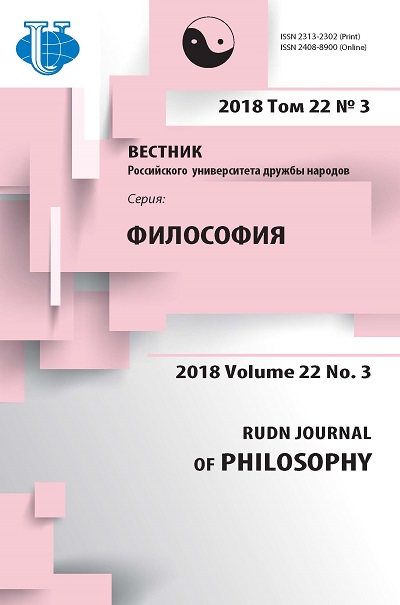ON THE ISSUE OF CLASSIFICATION OF BUDDHIST SACRAL FORMULAS
- Authors: Zorin AV1
-
Affiliations:
- The Institute of Oriental Manuscripts, Russian academy of sciences
- Issue: Vol 22, No 3 (2018)
- Pages: 330-340
- Section: HISTORY OF PHILOSOPHY
- URL: https://journals.rudn.ru/philosophy/article/view/19330
- DOI: https://doi.org/10.22363/2313-2302-2018-22-3-330-340
- ID: 19330
Cite item
Full Text
Abstract
This paper deals with the issue of classification and genre definitions of Buddhist sacral formulas known as dhāraṇī , mantra , hṛdaya , etc. The analysis is based on, first, the exploration of religious-philosophical background of the Buddhist approach to the texts of this kind (often called magical invocations, spells, etc.), second, the study of concrete textual data where such formulas are contained along with their denotations. Dealing with the first aspect, the author reconsiders an early but fruitful interpretation of dhāraṇī provided by V.P. Vasil’yev in the middle of the 19th century and not distinguished enough in the academic literature published in English. Most important for this paper is Vasilyev’s idea on the tight connection between dhāraṇī and the name considered as the essence of an object or a person so that its knowledge makes possible to grasp directly what is signified by the name. This idea, however, requires a certain clarification: the concept of emptiness of all dharmas and their sameness from the standpoint of the Ultimate Truth causes fundamental uncertainty in terminology when various definitions can be applied to the same sacral formulas being nothing but marks of different modes of their apprehension. This phenomenon is explored in the second part of the paper that analyzes concrete textual data extracted from the Tibetan Gzungs bsdus collection compiled by Tāranātha in the early 17th century. In spite of the attempts made by some Buddhist theorists to define criteria for the exact classification of the sacral formulas, the texts of dhāraṇī-sūtras show explicitly that the names of the genres can be loosely mixed and applied simultaneously to the same formulas.
Keywords
About the authors
A V Zorin
The Institute of Oriental Manuscripts, Russian academy of sciences
Author for correspondence.
Email: kawi@yandex.ru
кандидат филологических наук, старший научный сотрудник Института восточных рукописей РАН
Dvortsovaya emb., 18, St. Petersburg, Russian Federation, 191186References
- Cabezón JI. The Buddha’s Doctrine and the Nine Vehicles. Rog Bande Sherab’s Lamp of the Teachings. Oxford University Press; 2013.
- Davidson RM. Studies in Dhāraṇī Literature I: Revisiting the Meaning of the Term Dhāraṇī. Journal of Indian Philosophy, 37 (2); 2009, p. 97—147.
- Gonda J. Epithets in the Ṛgveda. ‘S-Gravenhage: Mouton & Co; 1959.
- Hidas G. Dhāraṇī Sūtras. In: Brill’s Encyclopedia of Buddhism. Vol. I. Literature and Languages. Eds. J. Silk, O. von Hinüber, V. Eltschinger. Leiden: Brill; 2015, p. 129—137.
- Jamgön Kongtrul Lodrö Tayé. The Treasury of Knowledge. Book Six, Part Four: Systems of Buddhist Tantra. The Indestructible Way of Secret Mantra. Kalu Rinpoché Translation group under the direction of Venerable Bokar Rinpoché. This volume translated by E. Guarisco and I. McLeod, introduced and annotated by E. Guarisco, and edited by I. McLeod. Ithaca, New York — Boulder, Colorado: Snow Lion Publications; 2005.
- Kappstein M.T. L’oubli des Russes: An (Almost) Forgotten Chapter in the History of 19th-century Orientalism. In: Revue internationale de philosophie. March 2019. (Forthcoming.)
- Uspensky V. Catalogue of the Mongolian Manuscripts and Xylographs in the St. Petersburg State University Library. Tokyo: Institute for the Study of Languages and Cultures of Asia and Africa; 1999.
- Vassilief V. Le Bouddhisme: ses dogmes, son histoire et sa littérature. Trad. du russe par G.A. La Comme et précédé d'un discours préliminaire par Éd. Laboulaye. Partie 1: Aperçu général. Paris: Durand; Duprat; 1863.
- Waddell LA. The Dhāraṇī Cult in Buddhism, its Origin, deified Literature and Images. Ostasiatische Zeitschrift, Heft II, July. Berlin; 1912, p. 155—195.
- Wassiljew W. Der Buddhismus, seine Dogmen, Geschichte und Literatur. Theil 1: Allgemeine Übersicht. Aus dem Russischen übers. [von Theodor Benfey]. St. Petersburg: Kaiserliche Akademie der Wissenschaften; 1860.
- Vasil’yev VP. Buddizm, ego dogmaty, istoriya i literatura. Chast’ 1. Obshchee obozrenie. St. Petersburg, 1857. (In Russ.)
- Ermakova T.V. Buddiyskiy mir glazami rossiyskikh issledovateley XIX — pervoi treti XX v. (Rossiya i sopredelnye strany). St. Petersburg: Nauka; 1998. (In Russ.)
- Zorin AV. U istokov tibetskoy poezii VIII—XIV vv. St. Petersburg: Peterburgskoe vostokovedenie; 2010. (In Russ.)
- Zorin AV., Sizova AA. Pervye pekinskie izdaniya sbornika “Sunduy” na tibetskom i mongol’skom yazykakh. Mongolica-XI. St. Petersburg: Peterburgskoe vostokovedenie, 2013. С. 37—44. (In Russ.)
- Shomakhmadov SKh. Sanskritskie dharani iz Serindiyskogo fonda IVR RAN. St. Petersburg, 2017. (Electronic file.) (In Russ.)
Supplementary files















